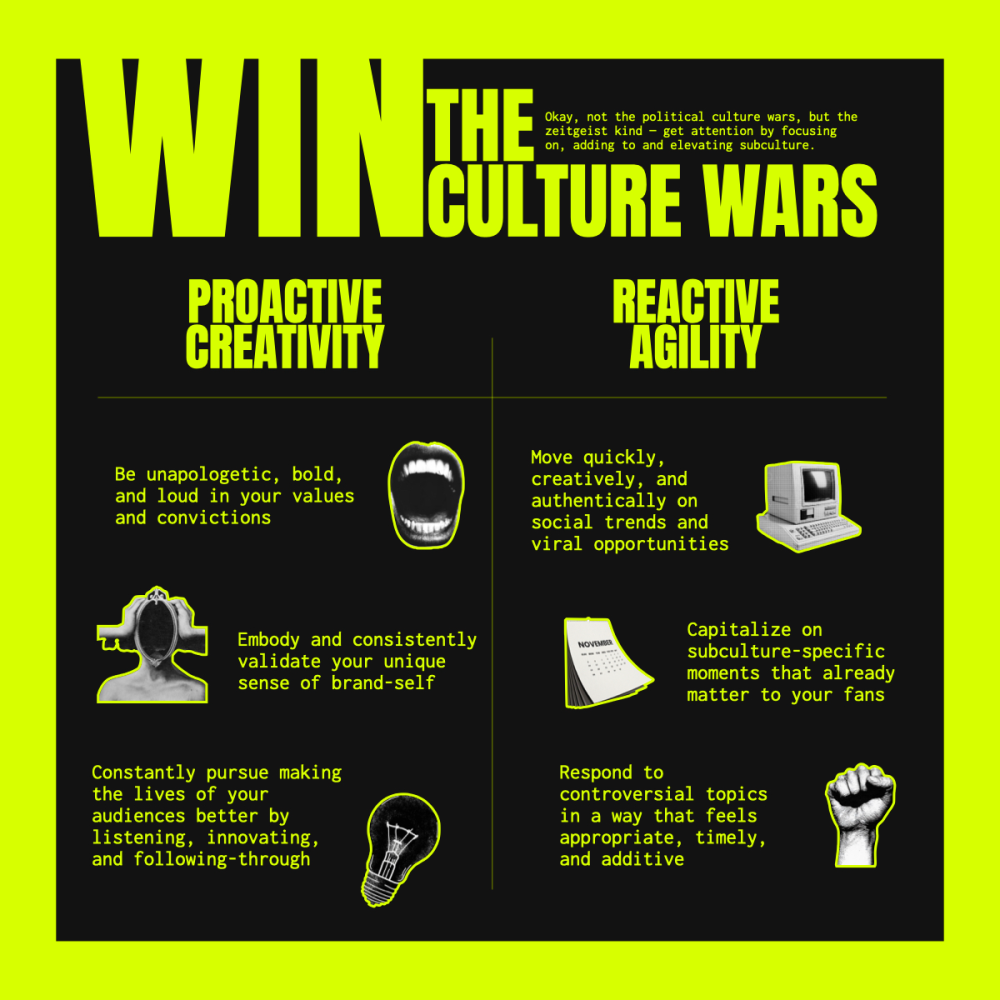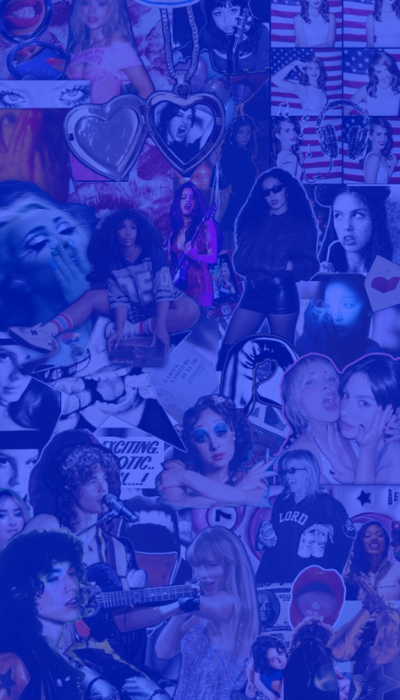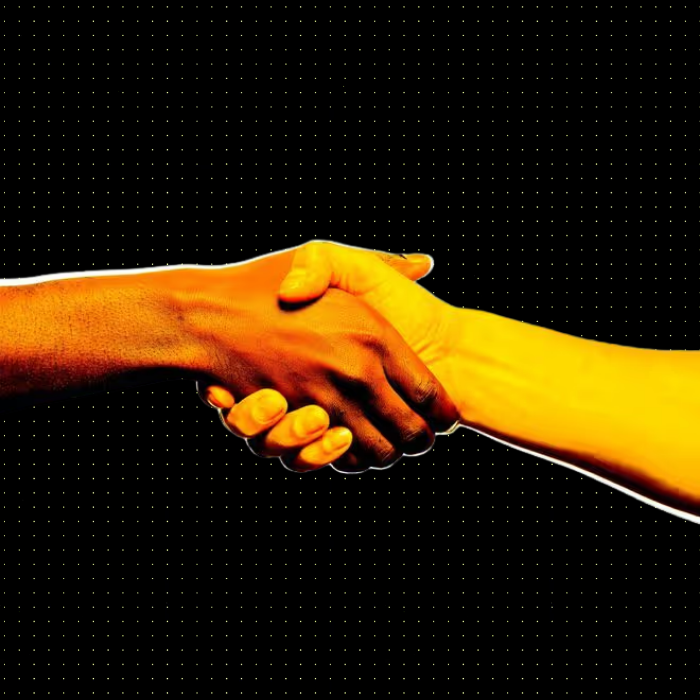Win the culture wars
Quick Snapshot: The media landscape isn’t just fragmented, it’s shattered — no more monoculture, just a million subcultures competing for attention. In this world, success isn’t about dominating the mainstream but making real impact within a subculture and letting that influence spill outward. The brands winning today do it two ways: proactive creativity (boldly standing in their values and driving cultural conversation) and reactive agility (jumping into moments with relevance and speed). It’s messy, divisive, and hard to pull off — but when it works, the attention is undeniable.
Okay, not the political culture wars, but the media/zeitgest kind (feels like a warzone, am i right?). The modern global media landscape is beyond fragmented, closer to shattered - 100+ social media platforms, 5k streaming services, 100k+ new sites (remember when there were like 10 TV channels, right, neither do I). We consume information and content conveniently served up to us by algorithms and gatekeepers and it’s all happening so quickly, no single person can keep up with it all. We no longer live in a monoculture where ideas become truly salient. Instead, redefined salience (and success) is about capturing the attention of a subculture and having some broader spillage (it’s the best we can do these days).
So the question becomes, how do I generate some attention within a subculture. You could pay for it, but paid media is visibility, not necessarily attention. You could own the media and algorithm, but we mere mortals couldn’t dream of that, and forced attention doesn’t a sustainable brand make anyway (looking at you Twitter). Or you can positively contribute to the culture, adding to and elevating the conversation and making the experience better for the subculture audiences.
Lol, okay, sounds hard. And it kind of is. But a handful of brands are doing it so well, and we have some lessons from their big wins (and “wins” is subjective here, because some of these tactics were quite broadly divisive but objectively made huge impact)
I see effectively contributing to subculture in two big actions - proactive creative and reactive agility.
Proactive creativity is landing on a set of values and not only sticking with them but being unapologetic, bold, and loud in your conviction. Nike does it well, by infusing human emotion into their stories, aligning with cultural movements, and doubling-down on partnerships amidst major backlash (think Colin Kaepernick). They are defining and driving conversation by being a vocal advocate for their values, and their fans love them for it. They aren’t appealing to everyone, how could they really, so they don’t even try. Those that get it, get it, those that don’t don’t (credit: the millions of Gen Z on TikTok that have said this).
Proactive creativity is embodying a sense of self (brand-self, I guess) and doing things that validate that and make it believable – from the influencers they partner with, to the owned content they put out, to the products it releases, it all feels like it’s coming from the same source of brand truth. Take Chili’s (note: I’m biased, I love Chili’s, not just for its marketing but the whole experience), over the past handful of years, it’s really leaned into this humorous, light, nostalgic vibe. Naturally, Chili’s as a restaurant chain (and brand) has evolved over its 50 years, and it had kind of become a… joke, for the lack of a better way of saying that (again, I love Chili’s so I say that with admiration). As much as it is absolutely a reliable, dependable fast casual eatery, suggesting it likely would receive a “uh, really?” reaction. It just wasn’t the “vibe”. And instead of resisting this “vibe” and trying to force a coolness, Chili’s leaned in with a wink and a nod – working with influencers who were unabashedly pro-Chili’s and would poke fun at Chili’s expense and launching special nostalgic product promotions (like the one with Tiffany Amber Thiesen from Saved by the Bell). They owned this evolved identity, their fans loved them for it, and they brought lots more fans into the fold in the process.
Proactive creativity is the constant pursuit of making the lives of your audiences better – being curious, determined, innovative, and actually able to get things done. Whether it’s special services, resources, content, or the products themselves, brands that so obviously exist FOR their audiences and show tangible proof of their contribution to their subculture receive lasting attention for their efforts. For example, Duolingo literally exists to make its users smarter (at least in another language), constantly motivating you, refining and expanding its services, and making the whole experience fun FOR YOU, all in an effort to create habits that last, to make you better.
Reactive agility is seeing what’s happening in certain controversial spaces (think politics, tech, etc), reading the room, and responding in a way that feels authentic, appropriate, timely, and is additive. For brands that have strong values and an unafraid disposition (like Nike, again), they make big, sentiment-heavy statements that reflect how they feel (and how they believe their consumers feel) about certain tough, divisive moments. They do this not necessarily to be part of the conversation and gain some attention, but because they really believe what they’re saying / doing and they believe that by so boldly showing up, they’re making a positive difference.
Reactive agility is capitalizing on subculture-specific moments with humility and grace – events, topics, people that your audiences already care about. Sometimes we have a bit more time to prepare for these (like Pride Month or Christmas) and sometimes we don’t (LA wildfires, hurricane relief), but no matter the circumstance, brands that show out (through advocacy, or funds, or awareness, etc) for the things that directly effect the lives of their fans deepen the relationships and trust of their broader community.
Reactive agility is moving quickly (and creatively) on social trends and viral opportunities, in ways that don’t feel opportunistic or forced, but adding to and continuing the moment. Chili’s (again) does a great job of being part of (and often-times, elevating) the joke. A content creator makes a video about the how “cringe” Chili’s is, and Chili’s responds with something funny in the comments, makes a reaction video with a different creator, or partners with the original creator. Or they’ll put their own spin on memes that are already happening organically and putting their own unique stamp on it for fans. Either way, Chili’s so clearly gets what’s happening and they’re using what is authentic to them to give their fans a great experience (even outside the walls of their restaurants).









.avif)


.avif)